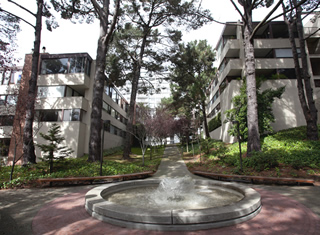City on a Hill
New to San Francisco and looking for a place to live, Calvin Jung was hoofing it west from downtown when he came upon something he didn’t expect in a city better known for Victorian gingerbread homes and Edwardian flats.
It was a neighborhood of high-rise housing, garden apartments, plentiful landscaping, a broad albeit busy boulevard, and a cathedral that does not look like Notre Dame.
“What is this neighborhood? This is amazing!” he thought. “It doesn’t feel like you’re in San Francisco.”
In a way, that was the intention. Jung, a designer recently relocated from Toronto, found himself in one of San Francisco’s bravest—or was it most foolhardy?—mid-century attempts to say ‘heave-ho to the old, let’s welcome in the new.’
 |
 |
|
|
 |
|
|
 |
|
|
It’s a place called Cathedral Hill today, after St. Mary’s Cathedral, certainly the most startling ecclesiastical structure in town, designed in 1970 by Pietro Belluschi and Luigi Nervi as a concrete parabolic cupola. It’s part of what is known, both yesterday and today, as the Western Addition.
“This area here,” says Thelma Damele, who grew up in the city, “was really old San Francisco.”
Back in the ‘50s and early ‘60s, it was called the A-1 redevelopment area, slated by the city for utopian reshaping, as bulldozers razed 4,000 mostly Victorian homes that were deemed to be ‘blighted,’ to make way for a more rational cityscape of low- and high-rise middle-class and mixed-income residential developments in a park-like setting, providing air and light and recreation and shopping for all.
Today, lovers of 19th century architecture decry the loss of some of the city’s loveliest housing stock—not to mention the destruction of African-American and Japanese-American communities.
Maxwell Gillette, whose father, like many African-Americans, came to San Francisco during World War II, was kicked out of the area in the early 1950s, when land clearance was getting underway. The family was promised they’d be able to move back—and even got a certificate saying so.
“Those certificates became worthless, just a piece of paper,” Gillette says. “We were not able to come back into the area. They did not honor the certificates.”
Gillette did wind up moving back to the neighborhood, though—more than two decades later when he and his wife Frankie bought a unit at Laguna Heights.
But at the time the most progressive social theorists, urban planners, and architects thought A-1 was the way to go—and so did Joe Eichler.
Eichler, a socially conscious man who enjoyed challenges, had done well as a suburban developer—but hadn’t made a mark on the inner city. The city’s Redevelopment Agency, which was seeking Western Addition developers, soon heard from him.
Eichler’s 1960 proposal was ambitious. As described in the July 1962 issue of Architecture/West, his neighborhood of ‘Laguna Heights’ would fill four adjacent blocks with three high-rises and with one cluster of six low rises.
He got the job.
The result, as Jung discovered to his pleasure, is one of the most unusual Eichler neighborhoods. It’s urban in every sense of the term, walking distance from the opera, symphony, museums, city hall, and downtown jobs—and near blocks of subsidized housing where it is inadvisable to walk at night.
Neither the Laguna Eichler tower at 66 Cleary Court, nor the low-rise Laguna Heights development, are as closely knit as many of Eichler’s suburban subdivisions, which are known for their block parties. Each is a distinct place; social connections between folks in the high-rise and folks in the low-rises are few, neighbors say.




